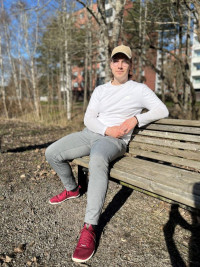How does the skeleton affect obesity and diabetes?

The human skeleton does much more than just passively support our bodies. In recent decades, the skeleton has been increasingly recognized as one of our internal organs. As a hormonal organ, the skeleton also influences our metabolism.
Bone is not just a passive support structure for humans but an active tissue that constantly renews itself while older bone tissue breaks down. Bone cells produce various hormones that affect, among other things, glucose metabolism, insulin production, and appetite regulation.
"Our bones engage in reciprocal communication with other internal organs, where endocrine proteins move between organs. These proteins affect insulin sensitivity and insulin release, among other things. Thus, they are a factor that influences our metabolism, weight, and possibly the development of type 2 diabetes," lists doctoral researcher Niki Jalava on the properties of bone.
Jalava has received a 15,000 € grant from the Instrumentarium Science Foundation for his doctoral research, titled "The Connection between Bone Metabolism, Obesity, and Diabetes: Bone as a Hormonal Organ."
Research using cell, animal, and human models
According to Jalava, the relationship between bone, obesity, and diabetes stems from biology. All parts and organs of the human body influence each other. Thus, for example, every movement and even a slight vibration moves the fluids within the skeleton. Bones have their own communication channels, the function of which has been studied to some extent previously. Much less research has focused on the communication between bone and other organs.
"The bone forwards molecules that affect, among other things, our sugar and fat metabolism. I have studied this relationship and function using cell, animal, and human models. In cell culture, I used stem cells from rats' bones and investigated how adding sugar to the cells affected their function. In animal experiments, some rats were fed a high-fat diet while others were not. In the study, we compare the differences between these groups. We collected bone marrow samples from humans at the Turku University Hospital in connection with knee replacement surgeries," says Jalava about the practices of his doctoral research.
The technology used in the research includes cell imaging, RNA isolation, and the elucidation of differences in proteins and genes between samples and control samples. Equipment includes a microscope, fluorescence measurement devices, and an RT-qPCR device (Real-Time Quantitative Polymerase Chain Reaction).
New solutions to humanity's major health problems
Jalava's future plans include working in the pharmaceutical industry and in drug development. Jalava, who studied biomedical sciences and graduated with a master's degree in 2021, investigates the properties of bone not only because of the subject's interest but also because of his future plans.
"As part of my doctoral research, I get to develop both my own laboratory skills and project management skills. Both are important and necessary in the field of drug development. Doctoral work also enhances my communication skills to be more versatile, as research results must be reported scientifically both in writing and orally," says Jalava.
The problems brought by obesity and type 2 diabetes are significant both for Finland and for humanity as a whole. Jalava wants to contribute to solving these problems and provide assistance to people through research and drug development.
Focus on research thanks to the grant
The dissertation, to be completed in 2025, is partially funded by the Instrumentarium Science Foundation grant. The research is conducted at the Institute of Biomedicine at the University of Turku as part of Kaisa Ivaska's research group. Jalava has received funding for his research from other sources as well, including the doctoral school at the University of Turku.
"The grant from the Science Foundation means a tremendous amount to me. Without it, I would have to focus on finding new funding channels instead of doing research. Now I can use my mental capital for the most important thing, which is the research itself. With the grant, I can pay my rent and live a normal life until the dissertation is completed."
Text: Kai Tarkka
Photo: Niki Jalava
